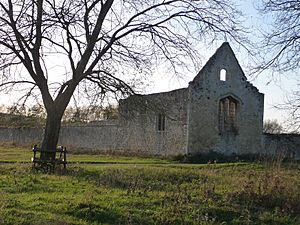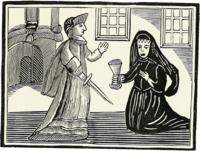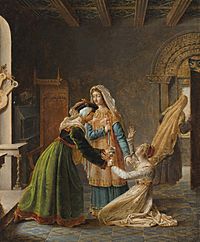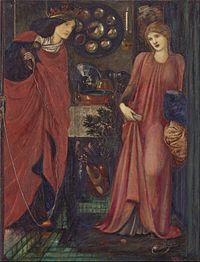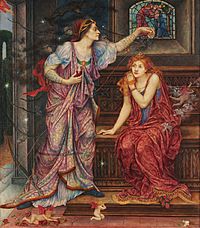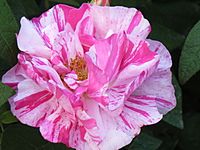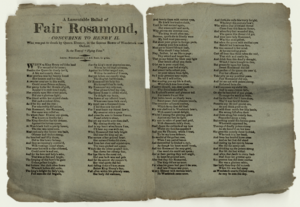Rosamund Clifford facts for kids
Quick facts for kids
Rosamund Clifford
|
|
|---|---|
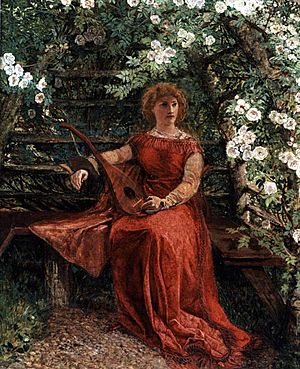
Fair Rosamund in her Bower by William Bell Scott (after 1854)
|
|
| Born | before 1140 Godstow Abbey, Godstow |
| Died | c. 1176 Godstow Abbey, Godstow |
| Companion | Henry II of England |
| Father | Walter de Clifford |
| Mother | Margaret |
Rosamund Clifford (born before 1140 – died around 1176) was a famous English noblewoman from the Middle Ages. She was often called "The Fair Rosamund" or "Rose of the World" (which in Latin is rosa mundi). Rosamund was a special friend to Henry II, who was the King of England. Her story became well-known in English folklore.
Contents
Rosamund's Life Story
Her Early Years
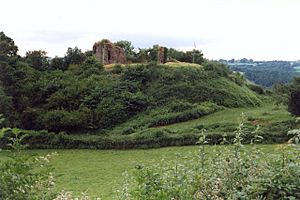
Rosamund Clifford was likely born before the year 1140. Her father was Walter de Clifford, an important lord who guarded the borderlands. Her mother's name was Margaret. Rosamund had three brothers named Walter, Richard, and Gilbert. She also had two sisters, Amice and Lucy.
Her name, Rosamund, probably came from the Latin words rosa mundi, meaning "rose of the world." Rosamund spent her early childhood at her father's home, Clifford Castle. Later, she was sent to a convent of Benedictine nuns at Godstow Abbey to get her education.
Her Connection to King Henry II
Rosamund Clifford was known for being one of the most beautiful women of the 12th century. Her special friendship with King Henry II (who lived from 1133 to 1189) is thought to have started around 1166. At this time, the King's wife, Queen Eleanor, was expecting their last child, John.
The King first openly showed his connection to Rosamund in 1174. Some stories say that Rosamund lived at Woodstock Palace. This might be why Queen Eleanor gave birth to their son John at Beaumont Palace instead of Woodstock. Historians are not sure if Rosamund stayed at Woodstock while the King traveled, or if she went with him.
Her Later Life and Death
When her friendship with the King ended, Rosamund went to live at Godstow Abbey. She died there around 1176, when she was less than 30 years old. She was buried at the Abbey. Her death was remembered at Hereford Cathedral on July 6th. This was the same day King Henry II died 13 years later.
The King and the Clifford family paid for the Benedictine nuns at the convent to take care of her tomb. Her burial place became a popular spot for local people to visit. In 1191, Hugh of Lincoln, who was the Bishop of Lincoln, noticed this. He asked the nuns to move Rosamund's body to the cemetery near their chapter house.
Sadly, her tomb was destroyed during the Dissolution of the monasteries (1536–1541) under King Henry VIII. Today, the ruins of Godstow Abbey can still be seen and are open to visitors.
A German traveler named Paul Hentzner visited England around 1599. He wrote that Rosamund's faded tombstone had an inscription. Part of it said: "Let them adore... and we pray that rest be given to you, Rosamund." It also had a rhyming epitaph that meant: "Here in the tomb lies the rose of the world, not a pure rose; she who used to smell sweet, still smells—but not sweet." People who saw the tomb before it was destroyed said it showed a chalice along with other carvings.
Rosamund in Folklore
In English folklore, many legends grew around Rosamund's story. One popular tale says that King Henry II tried very hard to hide his friendship with Rosamund from his wife, Queen Eleanor. He supposedly met Rosamund in a secret, complicated underground labyrinth at Woodstock Palace in Oxfordshire.
According to the story, Queen Eleanor heard rumours and found her way through the labyrinth. She then faced Rosamund and made her choose between a dagger and a bowl of poison. The legend says Rosamund chose the poison and died. However, this dramatic story first appeared in a 14th-century French book and was not written about by earlier historians.
Another version of the tale claims that the queen had Rosamund roasted between two fires, stabbed her, and left her to bleed to death in a bath of scalding water. These kinds of stories became very popular during the Elizabethan era. They led to poems like the Ballad of Fair Rosamund by Thomas Deloney (1612) and the Complaint of Rosamund by Samuel Daniel (1592). These works were purely fictional.
The idea of the underground labyrinth was added to the story in 1516. It was inspired by the tale of Estrildis, another king's friend who had secret underground rooms. The poisoned cup first appeared in a ballad in 1611.
Most historians from the Middle Ages say that Queen Eleanor was actually imprisoned by 1173. This was because she encouraged her sons to rebel against their father, the King. This makes it very unlikely that the two women ever met face-to-face as the legends describe.
Children and History
Historians have different ideas about whether Rosamund Clifford had children with King Henry II. Some legends have said that two of the King's sons, Geoffrey, Archbishop of York and William Longespée, were her children.
However, Geoffrey was born before the King and Rosamund even met. His mother was another woman. William Longespée was the son of Ida de Tosny. So, it seems these two famous sons were not Rosamund's children.
Fair Rosamund's Well and Green
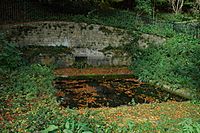
Local stories say that "Rosamund's bower" (which might have been an early version of the labyrinth) was taken down when Blenheim Palace was built. Today, Fair Rosamund's Well (51°50′42″N 1°22′04″W / 51.845070°N 1.3677058°W) is a paved spring in the park of Blenheim Palace in Woodstock, Oxfordshire. It is on the western side of The Lake. In 2014, a BBC article mentioned that the well had become "somewhat overgrown and at risk of becoming damaged."
Rosamund is also connected to the village of Frampton on Severn, Gloucestershire. This was another place her father owned. Walter de Clifford gave the mill there to Godstow Abbey to honor his wife and daughter. By the 17th century, the village green in Frampton became known as Rosamund's Green.
The Rosa Mundi Rose
There is a special type of rose called rosa gallica that has striped pink flowers. It is commonly known as rosa mundi. This rose has been linked to Rosamund Clifford since the 16th century.
Rosamund in Stories and Art
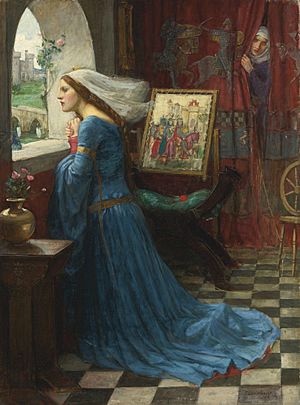
Rosamund Clifford's story has inspired many books, plays, and operas over the centuries.
In Literature
- The Complaint of Rosamund, a poem from 1592 by Samuel Daniel.
- The Saint (German: Der Heilige), a novel from 1879 by Conrad Ferdinand Meyer.
- Rosemonde, a poem from 1913 by Guillaume Apollinaire.
- Eleanor the Queen, a 1955 novel by Norah Lofts.
- Penmarric, a 1971 family story by Susan Howatch (Rosamund appears as Rose Parrish).
- The Courts of Love: The Story of Eleanor of Aquitaine, a 1987 novel by Jean Plaidy.
- The Falcon and the Flower, a 1988 romance novel by Virginia Henley.
- Wings of the Storm, a 1992 novel by Suzan Sizemore.
- Always, a 2000 novel by Lynsay Sands (Rosamund is mentioned).
- The Book of Eleanor, A Novel of Eleanor of Aquitaine, a 2002 novel by Pamela Kaufman.
- Time and Chance (2002) and Devil's Brood (2008), two novels by Sharon Kay Penman.
- Death at Blenheim Palace, a 2006 novel by Robin Paige.
- The Death Maze (also called The Serpent's Tale in the U.S.), a 2008 novel by Ariana Franklin.
- The Time of Singing, a 2008 novel by Elizabeth Chadwick (Rosamund is mentioned).
- The Captive Queen: A Novel of Eleanor of Aquitaine, a 2010 novel by Alison Weir.
- The Winter Crown, a 2014 novel by Elizabeth Chadwick.
- La Révolte (The Revolt), a 2018 French novel by Clara Dupont-Monod.
In Cinema
- The Lion in Winter is a 1968 movie based on a play, and it hints at Rosamund's story.
In Theatre
- Henry II is a play from 1692 by William Mountfort.
- The Lion in Winter is a play from 1966 by James Goldman (Rosamund is hinted at).
In Opera
- Rosamond, a 1707 opera by Thomas Clayton.
- Rosamond, a 1733 opera by Thomas Arne.
- Rosamund, a 1780 German Singspiel by Anton Schweitzer.
- Rosmonda d'Inghilterra ("Rosamund of England") is an 1834 Italian opera by Gaetano Donizetti.
- Fair Rosamond is an 1837 opera by John Barnett.


